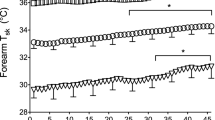Abstract
In an attempt to detect differences in the thermal effect of infrared irradiation of different wavelengths, transient sweating response to infrared irradiation in various spectral regions was examined. In Series 1, the ventral or dorsal surface of the nude subject was irradiated repetitively for a period of 4 min (2 min on, 2 min off) by each of three kinds of infrared heaters with main emissivity in ‘near-infrared’ (NIR; 0.7–2.8 μm), ‘intermediate-infrared’ (MIR; 1.5–5.8 μm), and ‘far-infrared’ (FIR; 2.8–25 μm) regions. The sweating response on a non-irradiated area tended to be the greatest with MIR, while the magnitude of the sweating response on the irradiated area showed no consistent differences among various wavelengths. The results infer that MIR stimulated cutaneous thomoreceptors most effectively, while its direct effect on local sweat gland activity was minimal. In Series 2, the effects of 9–12 min irradiations in more restricted ranges of wavelength were compared by the combination of the three kinds of heaters with filters (translucent to wavelength ranges of 1.3–2.7, 2.7–3.5, 3.6–8.0 μm, respectively). The sweating response on a remote area was predominantly greater with the range of 2.7–3.5 μm than with the other wavelength ranges, while the local effect on sweating was minimal with this range. The results of Series 2 reinforce those of Series 1, indicating that the degree of stimulation of cutaneous thermoreceptors and of direct thermal effect on sweat gland activity differ with spectral regions incident on the skin, thus affecting local and remote effects on the sweating response.
Similar content being viewed by others
References
Anderson RR, Parrish JA (1981) The topics of human skin. J Invest Dermatol 7:13–19
Hardy JD (1962) Physiological effects of high intensity infrared heating. ASHRAE J 4:36–42
Hensel H (1981) Thermoreception and temperature regulation. Academic Press, London New York Toronto Sydney San Francisco
Hashimoto K (1982) Topographic anatomy of the skin (in Japanese). In: Yamamura et al. (eds) Handbook of current dermatology, Vol 3. Structure and function of the skin. Nakayama Shoten, Tokyo, pp 313–333
Hensel H, Andres KH, During Mv (1974) Structure and function of cold receptors. Pflugers Arch 352:1–10
Kawamoto K (1988) Studies on infrared heating and infrared sources (in Japanese). Proc Infrared Soc Jpn 14:3–20
Matsui M (1987) Dependency of cutaneous thermal sensation to infrared radiation upon its wavelength (in Japanese). Proc Infrared Soc Jpn 12:18–26
Nadel ER, Bullard RW, Stolwijk JAJ (1971) Importance of skin temperature in the regulation of sweating. J Appl Physiol 31:80–87
Ogawa T (1974) Generalized sweat response in sweat rate to periodic cutaneous heating—with special reference to its relationship to heat tolerance. Jpn J Physiol 24:475–489
Ogawa T, Asayama M (1986) Quantitative analysis of the local effect of skin temperature on sweating. Jpn J Physiol 36:417–422
Oppel TW, Hardy JD (1937) Studies in temperature sensation. II. The temperature changes responsible for the stimulation of the heat end organs. J Clin Invest 16:525–531
Sugenoya J, Ogawa T (1985) Characteristics of central sudomotor mechanism estimated by frequency of sweat expulsion. Jpn J Physiol 35:783–794
Takagi S, Tobaru K (1954) Notes on the vertical distribution of the human sweat glands. Jpn J Physiol 4:169–174
Terada N, Ohnishi K, Kobayashi M, Kunimoto T (1986) Spectral radiative properties of a living human body. Int J Thermophysics 7:1101–1113
Yaglou CP, Minard D (1957) Control of heat casualties at military training centers. Am Med Assoc Arch Ind Hlth 16:302–316
Author information
Authors and Affiliations
Rights and permissions
About this article
Cite this article
Ogawa, T., Sugenoya, J., Ohnishi, N. et al. Dynamic sweating response of man to infrared irradiation in various spectral regions. Int J Biometeorol 35, 18–23 (1991). https://doi.org/10.1007/BF01040958
Received:
Revised:
Accepted:
Issue Date:
DOI: https://doi.org/10.1007/BF01040958




